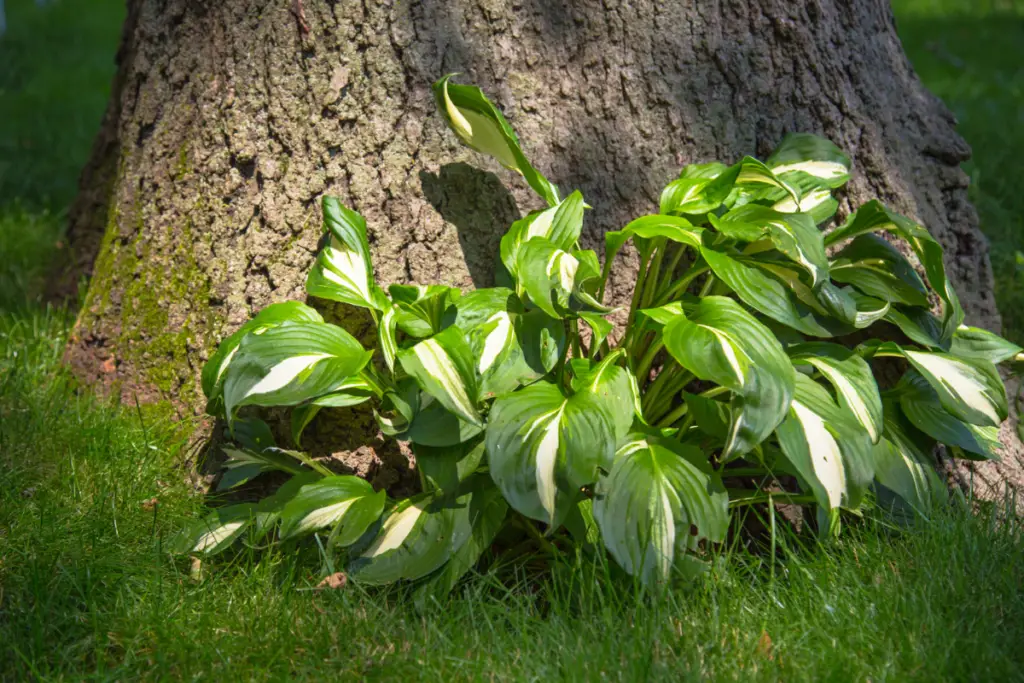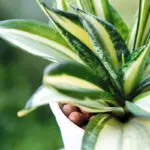Hostas are a popular plant choice for gardeners looking to add a touch of greenery to their outdoor space.
These shade-loving perennials are known for their lush foliage and low maintenance requirements. One creative way to incorporate hostas into your garden design is by planting them around trees.
Planting hostas around trees is a great way to add visual interest to your garden while also making the most of limited space.
Hostas can thrive in the dappled shade provided by a tree’s canopy, and their low-growing habit makes them the perfect ground cover.
This technique is especially useful for gardeners with small yards or those looking to create a natural-looking woodland garden.
To successfully plant hostas around trees, there are some important steps to follow. These include selecting the right hosta varieties, preparing the soil, and ensuring the plants receive adequate water and nutrients.
With the right care and attention, hostas can thrive in this unique garden setting and add a touch of natural beauty to your outdoor space.

Table of Contents
Understanding Hostas
Hostas are a popular choice for gardeners who want to add texture and interest to their landscapes.
These perennial plants are known for their large, lush leaves that come in a variety of shades of green, blue, and variegated colors.
They are also known for their ability to thrive in shady areas, making them an ideal choice for planting around trees.
Hostas are easy to grow and require minimal maintenance. They can be planted in the spring or fall, and prefer well-drained soil that is rich in organic matter.
They can also be grown in containers, making them a great choice for small gardens or balconies.
One of the benefits of planting hostas around trees is that they can help to fill in bare spots in the landscape.
They can also provide a sense of balance and completeness to the garden. When planting hostas around trees, it is important to consider the size and shape of the tree, as well as the amount of sunlight that the area receives.
Hostas are also a great choice for those who want to attract pollinators to their garden. They produce attractive flowers in the summer, which can attract bees, butterflies, and other beneficial insects.
Some varieties of hostas also produce fragrant flowers, which can add a pleasant scent to the garden.
Overall, hostas are a versatile and attractive plant that can add beauty and interest to any landscape. Whether planted in the ground or in containers, they are a great choice for those who want to add texture and color to their garden.
Choosing the Right Trees for Hostas
When it comes to planting hostas around trees, choosing the right trees is crucial. The trees you select will impact the amount of sunlight and water your hostas receive, which can affect their growth and overall health.
Here are some factors to consider when selecting trees for hostas.
Shade Tolerant Trees
Hostas thrive in shady environments, making shade tolerant trees a great option for planting hostas around them. Some popular shade tolerant trees to consider include:
- Japanese Maple
- Dogwood
- Redbud
- Hemlock
- Spruce
- Pine
These trees not only provide the necessary shade for hostas but also add beauty and texture to the landscape.
When planting hostas around shade tolerant trees, it’s important to ensure that the hostas receive enough moisture, as the trees may compete for water.
Deciduous Trees
Deciduous trees are another excellent option for planting hostas around. These trees offer partial shade during the spring and summer months and allow more sunlight to reach the hostas during the fall and winter.
Some popular deciduous trees to consider include:
- Oak
- Birch
- Maple
- Sweet Gum
- Elm
When planting hostas around deciduous trees, keep in mind that the leaves will fall during the fall season.
It’s important to clear the fallen leaves regularly to prevent them from smothering the hostas.
In summary, choosing the right trees for hostas is essential for their growth and overall health.
Shade tolerant trees and deciduous trees are both great options to consider, depending on your preferences and the environment in which you are planting.
Planting Ideas for Hostas Around Trees
When it comes to planting hostas around trees, there are a few different options to consider.
Some gardeners prefer to plant hostas under the canopy of the tree, while others choose to plant them at the base of the tree.
Both methods can be effective, depending on the look you are going for and the conditions in your garden.
Under-Canopy Planting
Planting hostas under the canopy of a tree can create a beautiful, lush look in your garden. This method works particularly well if the tree has a high, open canopy that allows plenty of light to filter through to the ground.
Hostas planted under the canopy of a tree will generally receive dappled or partial shade, which is ideal for these shade-loving plants.
When planting hostas under the canopy of a tree, it’s important to choose the right varieties. Look for hostas that are known for their ability to thrive in low light conditions, such as the ‘Sum and Substance’ or ‘Frances Williams’ varieties.
These hostas have large, bold leaves that can add a dramatic touch to your garden.
Tree Base Planting
Planting hostas at the base of a tree is another popular option. This method works particularly well if the tree has a thick trunk and a wide base that provides plenty of space for planting.
Hostas planted at the base of a tree can create a natural, organic look that blends in seamlessly with the surrounding landscape.
When planting hostas at the base of a tree, it’s important to consider the size of the tree and the amount of light that reaches the ground.
Hostas planted at the base of a tree that receives full sun may struggle to thrive, so it’s important to choose varieties that can tolerate some sun exposure. Look for hostas with thicker leaves, such as the ‘Blue Angel’ or ‘Patriot’ varieties.
No matter which method you choose, planting hostas around trees can add a beautiful touch to your garden.
With the right varieties and planting techniques, you can create a lush, vibrant landscape that will be the envy of your neighbors.
Tips for Caring Hostas Around Trees
When planting hostas around trees, it is important to care for them properly to ensure that they thrive and add beauty to your garden. Here are some tips for caring for hostas around trees.
Watering Tips
Hostas require regular watering, especially during dry spells. The soil around the tree should be kept consistently moist but not waterlogged.
Watering should be done in the morning or evening to avoid evaporation during the heat of the day.
A drip irrigation system is a good option for watering hostas, as it delivers water directly to the roots and keeps the foliage dry, which helps prevent disease.
Mulching Tips
Mulching is an important step in caring for hostas around trees. A layer of mulch around the base of the hostas helps retain moisture in the soil, suppress weeds, and regulate soil temperature.
Organic mulches such as shredded leaves, straw, or wood chips are the best options for hostas.
The mulch should be applied in a layer about 2-3 inches deep, taking care not to cover the base of the plant.
Pruning Tips
Pruning is an essential part of caring for hostas around trees. Dead or damaged foliage should be removed promptly to prevent the spread of disease.
Hostas can also be divided every few years to keep them healthy and promote new growth. Dividing should be done in the spring or fall when the plant is dormant.
To divide, dig up the entire plant, separate the root ball into sections with a sharp knife, and replant the sections in a new location.
By following these tips for caring for hostas around trees, gardeners can enjoy beautiful, healthy plants that add color and texture to their landscape.
Common Problems and Solutions
Hostas are generally easy to grow and maintain, but like any plant, they can experience problems.
Here are some common issues that may arise when planting hostas around trees and how to solve them.
Pest Issues
Hostas are particularly susceptible to slug and snail damage. These pests can cause significant damage to the leaves and can even kill the plant. To prevent slug and snail damage, gardeners can:
- Use slug and snail bait
- Handpick slugs and snails from the plant
- Create a barrier around the plant using copper tape or diatomaceous earth
Other common pests that may affect hostas include aphids, spider mites, and mealybugs. These pests can be controlled with insecticidal soap or neem oil.
Disease Issues
Hostas may also experience disease issues, such as:
- Crown rot: This fungal disease can cause the plant to wilt and die. To prevent crown rot, avoid planting hostas in poorly drained soil and ensure they are not overwatered.
- Leaf spot: This fungal disease causes brown spots to appear on the leaves. To prevent leaf spot, water the plant at the base and avoid getting the leaves wet.
- Virus: Hostas may be affected by several viruses, which can cause stunted growth and distorted leaves. Unfortunately, there is no cure for viral infections, so infected plants should be removed and destroyed.
To prevent disease issues, gardeners can:
- Plant hostas in well-drained soil
- Avoid overhead watering
- Provide adequate air circulation around the plant
By following these tips, gardeners can minimize the risk of pest and disease issues and ensure their hostas thrive around trees.
Conclusion
In conclusion, planting hostas around trees can be a great way to add some greenery and texture to your garden. These shade-loving plants can thrive under the canopy of trees, provided that you follow some basic planting guidelines.
Firstly, it’s important to select the right hosta variety for your garden. There are many different types of hostas available, each with their own unique characteristics and growth habits.
Some varieties may be better suited to shady areas, while others may require more sunlight.
By doing some research and selecting the right hosta for your garden, you can ensure that your plants will thrive and add beauty to your landscape.
Secondly, it’s important to prepare the soil properly before planting your hostas. This may involve adding compost or other organic matter to improve soil structure and fertility.
By providing your hostas with a healthy growing environment, you can help them establish strong root systems and grow into healthy, vibrant plants.
Finally, it’s important to maintain your hostas properly once they are planted. This may involve watering them regularly, fertilizing them periodically, and keeping them free from pests and diseases.
By taking good care of your hostas, you can ensure that they will continue to thrive and add beauty to your garden for years to come.
Overall, planting hostas around trees can be a rewarding and enjoyable gardening experience.
By following some basic planting guidelines and taking good care of your plants, you can create a beautiful and vibrant garden that will be the envy of your neighbors.
- How to Dry Basil Leaves: A Professional Guide
- Is an Avocado a Fruit or Vegetable? Simple Answer and Explanation
- Does Pineapple Have Seeds? Exploring the Anatomy of Pineapples
- Blooming Through Winter: Can I Grow Vegetables Indoors in the Winter?
- What Can You Grow in a Greenhouse All Year Round: A Guide to Year-Round Greenhouse Gardening
- Are Blueberries Blue? Debunking the Myth of Their Color
















